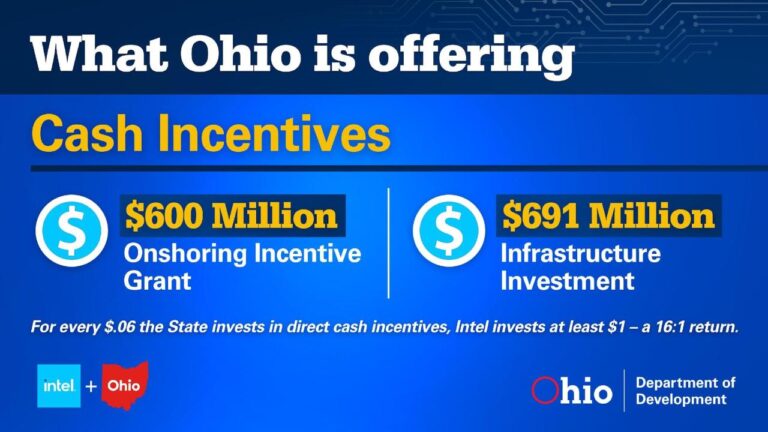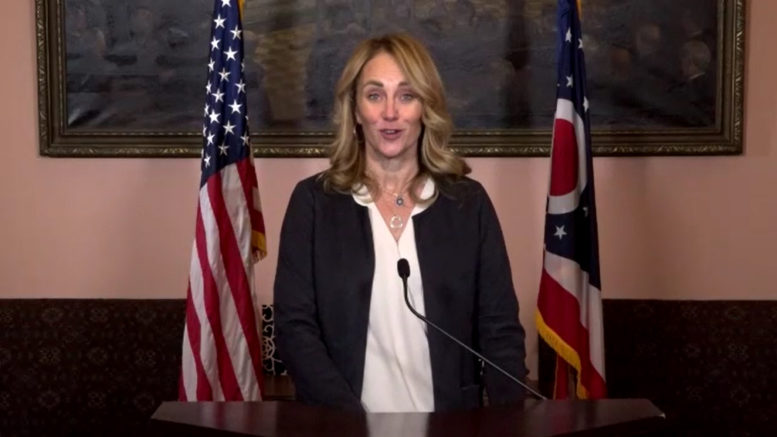BY NICK EVANS
So how long does it take for paint to dry?
A week ago, just after announcing what Ohio leaders are calling the biggest economic development deal in the state’s history, Lieutenant Governor Jon Husted wouldn’t say much about the incentive package that lured Intel to Ohio. The only information he shared at the time was $1.2 billion in infrastructure spending, but he insisted details were forthcoming.
“Fairly soon,” he said, “the paint won’t dry on it. We’ll probably get, I mean it won’t be on Saturday, but there’ll be a release.”
Friday, Ohio Department of Development Director Lydia Mihalik began filling in the gaps and updating that bottom line dollar figure. Instead of roughly $1 billion, the state is offering more like $2 billion. And from the outset Mihalik warned she would not be revealing the full scope of incentives.
“This administration is committed to an open and transparent process, but,” she emphasized, “it will be a process, given the scale of what we are undertaking.”

Mihalik first reiterated the scope of the project — $20 billion in capital investments, 7,000 construction jobs, 3,000 jobs at the facility and thousands more created indirectly. She explained internal projections put Intel’s contribution to the state economy at $2.8 billion annually. Then, Mihalik turned the to state’s offer to Intel.
“So, we really look at these in three buckets,” Mihalik explained. “Direct investment in the company, a direct cash investment in the community to support the growth, and that job creation tax credit.”
Under the terms, Intel will receive $600 million in performance-based grants to defray the cost of building its facilities. Mihalik, former mayor of Findlay, explained she was most excited about another $691 million in local infrastructure improvements for roadwork, wastewater and water reclamation upgrades. Lastly the state will offer Intel an expanded job creation tax credit, established as part of the most recent state budget. Instead of running for 15 years, major projects like Intel can claim the performance-based credit for 30. Mihalik said it would be worth about $650 million over that term.
If that were the sum total of inducements, it seems like a pretty good deal for Ohio, at least economically. Even if all the investments Mihalik described were offered annually, the state would still come out ahead so long as that $2.8 billion projection for Intel holds. But what Mihalik described isn’t the sum total, and officials have been cagey about the extent of the promises made to the chipmaker.
“I can speak directly to what the state has put on the table relative to the direct cash and then the job creation tax credit, but I can’t speak to what JobsOhio has offered nor what the locals have placed on the table,” Mihalik said.
“I would say to you that in order to land a deal of this magnitude it took a ‘Team Ohio’ effort,” she added when pressed, “and I’m only here today to speak about the state’s portion.”
In a press release, JobsOhio CEO J.P. Nauseef added one more piece to the puzzle.
“To support this transformational project, JobsOhio plans to assist Intel with $150 million in combined economic development and workforce grants,” he wrote. “After any final agreements are executed, JobsOhio will post that assistance on its website.”
In addition to the incentives coming from Ohio, Intel stands to gain from a pool of $52 billion in the so-called CHIPS Act working its way through Congress. The proposal, meant to encourage domestic semiconductor production, counts both of Ohio’s U.S. Senators among its backers. Speaking after the Intel announcement last week, Ohio Democratic U.S. Sen. Sherrod Brown was direct about the bill’s prospects.
“Senator Portman and I and others will team up and make this happen,” he said.
***
Also from Ohio Capital Journal:
With enough signatures in, recreational marijuana bill goes to the legislature
If lawmakers can’t or won’t pass a proposed bill, recreational marijuana in Ohio could be a matter for the people to decide.
Secretary of State Frank LaRose said Friday that the Coalition to Regulate Marijuana Like Alcohol submitted enough valid signatures to set in motion what’s known as an “initiated statute” process.
The coalition gathered 136,729 valid signatures spanning all Ohio’s 88 counties, according to LaRose. Those signatures plop the coalition’s proposed bill onto the Ohio General Assembly’s plate.
Lawmakers now get four months to pass the bill as is, amend it, or ignore it. If they go with the latter two options, the coalition can either accept the legislature’s response or gather another roughly 133,000 signatures to place the question of marijuana legalization on the general election ballot.
The proposal allows for the possession of up to 2.5 ounces of marijuana or 15 grams of marijuana extract. Adult Ohioans could purchase marijuana at retail locations or grow two plants at home (four if there are two adults living in the household). Products would be taxed at 10%. READ MORE





